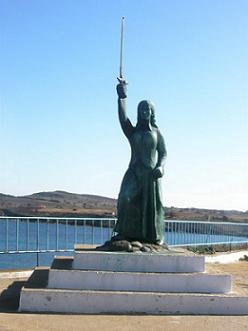| The Greek islands | Limnos HOME | Limnos Hotels | Limnos Beaches | Limnos Villages | Limnos Sights |
|
|
|
|
|
|
|
|
|
|
|
|
| The sights of the island of Limnos |
|
The Archaic city of Poliochni in the south west of the island, 9 kilometer east of Moudros, is the most important archeological site of the island. It dates from 4000 BC and is the oldest settlement in the Aegean. It was a city of merchants (and not of a king) that traded with the island of Crete, islands in the Cyclades and with cities on the coast of Asia Minor (for instance Troy). The sight is open to the public between 9.00 - 15.30 (closed on monday) and there is an entrance fee. There are remains from walls, towers, houses and other buildings. An earthquake in 1300 BC ended the prosperity of the town. The classical city at Hephaisteia or Ifestia which includes the remains of a temple dedicated to the God Hephaistos (Vulcan, the God of metal and fire). The myth tells that it is build on the spot where Hephaistos landed after Hera threw him from Mount Olympus. The city is situated 9 kilometers north east of Moudros and it was the capital of the island between 1200 and 1000 BC. The remains are spread over the hills and sometimes it is difficult to recognize what they were. There are remains of houses, a cemetary, a theatre and the Hephaistos temple. The city was destroyed by the Persians in 511 BC and later rebuild by the Athenians. The sanctuary at Kavirio a little north east of Hephaisteia was dedicated to the three sons and three daughters of Hephaistos and Kavirio. These Gods were connected with fertility of the earth and the protection of sailors. Only a part of the columns and a temple have been excavated. There are two lakes on the island of Limnos, Limni Aliki and Chortarolimni. The first one is a salt lake from which salt used to be extracted for a long time, and Lake Chortarolimni has completely dried out. This second lake is a small nature reserve. In the winter months it offers refuge to flamingos and other birds and in the summer when the lake is dried up it turns completely white. Lemnos has got its own Petrified Forest (just like the island of Lesbos). Remnants of this forest can be found around the villages of Varos, Rossopouli, Moudros, Thanos and Kontias. 23 to 18 milion years ago the surface of Lemnos was covered by a dense forests of palms, pine-trees and huge redwood trees, which were buried under the lava. The Kastro of Myrina is build on the site of an ancient acropolis. It is one of the largest castles in the area. The Byzantine Emperor Andronikos I started the construction in 1186 AD and the Venetian that ruled the island in between 1207 and 1269 completed it. In 1269 the island of Limnos came into Byzantine hands again and the castle was made even stronger. Large parts of the walls and gates have been restored after much was damaged by the Russians when they besieged the castle in 1770. It is worth to make the climb to the castle and have a look around. Remarkable is that there are a lot of deer walking around free in the large walled premises of the castle. From the castle there are also amazing views. On a clear day you can see the holy mountain Athos (2033 m) on Chalkidiki peninsula.
In Kotsinas just outside the yard of the Church and overlooking the sea, stands the statue of a local hero holding up a sword. It is a woman named Maroula. In 1478 the people from Limnos joined the Venetian forces to battle against the Ottoman Turks. Maroula saw how her father was killed by an invader while he was defending the entry to the fort. She picked up his sword, which was lying beside him and then charged against the enemy with much ferocity, inspiring the other people of Limnos. Thus she became the symbol of heroism. The combined forces and the heroism of Maroula forced the Turkish invaders to take their ships and flee from the port. The freedom did not last very long. In 1479, one year later, the island was occupied again and remained so until it was joined with Greece again in 1912. Kotsinas is a small village situated in a bay. There are a couple of tavernes and there is a concrete pier and a small harbour with fishing boats. On the north side of the village lies the beach backed by sand dunes. One of the hotels on my page (the Varos Village Hotel) has set up its own private part of beach with free sunbeds and parasols, and a snackbar. The beach is 3 minutes away from the hotel by (free) shuttle bus service. |
© Hans Huisman, Varos Village Hotel, Archontiko Hotel, https://www.angelfire.com/super2/greece/ 2014
 In Kotsinas (sometimes spelled "Kotsinos) you find the Byzantine Castle of Kotsinas which was built in Kotsinos castle was not built in 1207 during the 4th crusade occupation by the Venetian family of Navigajosi. In 1361 it was repaired by the Gatelusi family who ruled Lemnos up until the Turkish occupation.
In Kotsinas (sometimes spelled "Kotsinos) you find the Byzantine Castle of Kotsinas which was built in Kotsinos castle was not built in 1207 during the 4th crusade occupation by the Venetian family of Navigajosi. In 1361 it was repaired by the Gatelusi family who ruled Lemnos up until the Turkish occupation.